The Google Nexus 5X Review
by Brandon Chester on November 9, 2015 8:00 AM EST- Posted in
- Smartphones
- LG
- Mobile
- Android 6.0
- Nexus 5X
Display
A smartphone's display is unquestionably one of its most important aspects, and failing to deliver a good display can be a fatal flaw for a device. If the screen doesn't have sufficiently high brightness and contrast then its usability with high ambient lighting will be severely crippled. Inaccurate color rendition will cause photos and videos that are taken and viewed on the device to look radically different from other devices. Pushing a wide color gamut can also have ramifications that go beyond making the display inaccurate, such as reducing battery life on AMOLED devices by having to drive a higher voltage in order to achieve the wider gamut.
Last year's Nexus 6 ended up being a significant disappointment as far as the display was concerned. It was immediately obvious to me that the gamut was far too large, and that peak brightness was too low. My testing confirmed both of these things, and I was disappointed mainly because the Nexus 5 from the previous year sold for significantly less than the Nexus 6, and sported imperfect but relatively good display calibration. While this year's Nexus 6P is an AMOLED display that we are yet to test, the Nexus 5X sports an IPS LCD like its predecessor. At 5.2", this year the display is a bit bigger than the 4.95" Nexus 5, but it's still a far cry from the 5.96" display that was on the Nexus 6.
To analyze the quality of the Nexus 5's display I've run it through our standard display testing suite. As always, displays are calibrated to 200nits of brightness, and results are measured with an i1Pro 2 spectrophotometer, and managed using SpectraCal's CalMAN 5 software. Contrast measurements are done with an i1Display Pro colorimeter due to the i1Pro 2's more limited accuracy with very low brightness levels.
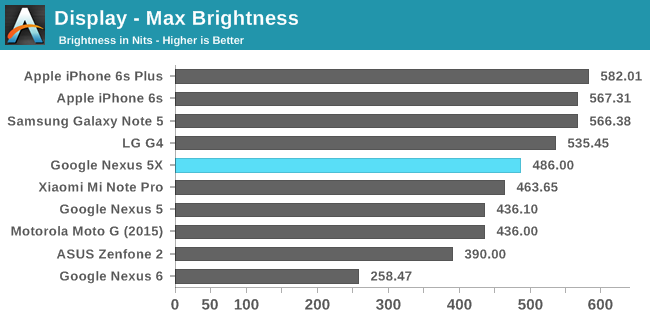

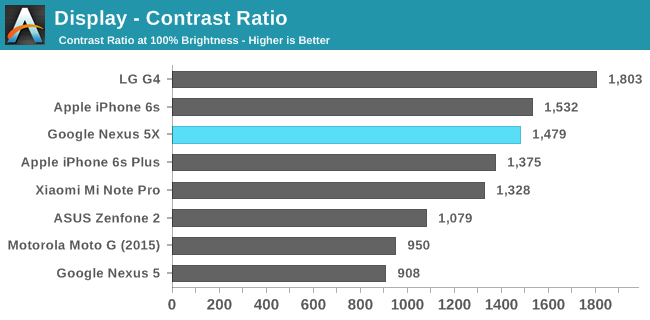
The most basic data point to examine when moving beyond resolution is a display's maximum brightness and its contrast ratio. The Nexus 5X does very well here, with a peak brightness of 486 nits, and a minimum black level of 0.32 nits, which leads to a contrast ratio of 1479:1. This is the result of the use of photo-alignment to influence subpixel orientations and reduce light leakage, which results in deeper blacks and thus a higher contrast ratio. While many other LCD-based smartphones are also using this technology, to see it applied to a $379 smartphone is very exciting. The display's maximum brightness is also a healthy improvement over the Nexus 5, and I haven't run into any situations where the display can't get bright enough to counter glare from the cover glass.
Something that doesn't really show up in any of our figures is the visibility of the display's capacitive sensors. On the Nexus 5 these were fairly noticeable when there was any light shining on the display, and this is unchanged on the Nexus 5X. This is something that can be observed on every device with capacitive touch, although on AMOLED devices and iPhones it's extremely hard to see. I only felt it was worth pointing out because it does seem more pronounced on the Nexus 5X than some of the other devices I have.
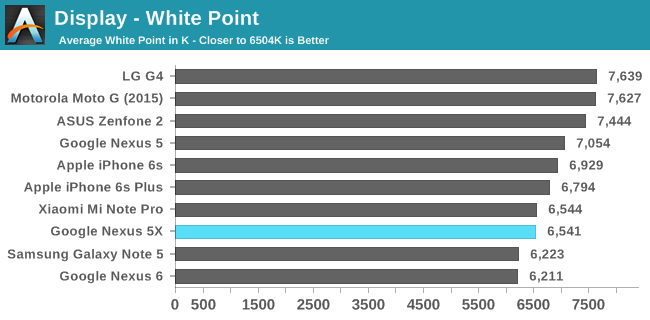
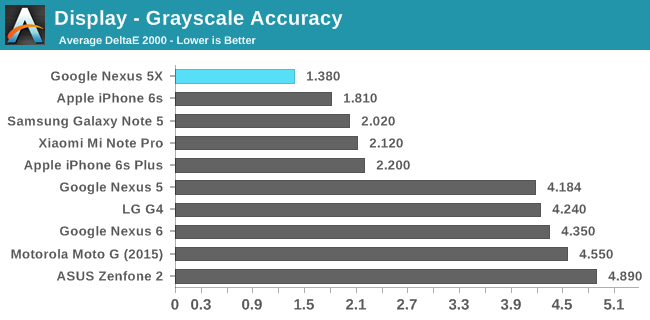
Greyscale accuracy on the Nexus 5 is impeccable. Gamma does tend slightly upward as one moves past the 20% mark, but it's still quite accurate and most greyscale errors are approaching the point where the human eye could not even distinguish them from their reference colors when placed side by side. The RGB component balance for each shade of grey is also very good, and the display's average white point is only ever so slightly above the targeted 6504K. There's not much more to say, as this level of calibration is exceptional for a device of this price. The Nexus 5 certainly had fairly good calibration, but issues with the gamma made the display appear washed out which was a common complaint, and the Nexus 5X resolves that while also boosting accuracy significantly.
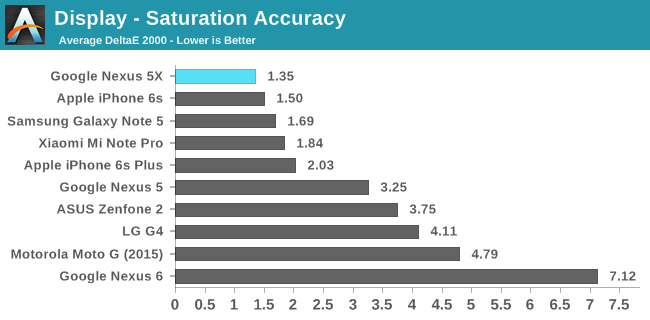
The accuracy for 20% saturation steps on the Nexus 5X is also incredibly high. It's actually the lowest DeltaE on record for a smartphone - lower than even the Galaxy Note5 and iPhone 6s - and there's honestly nothing at all that I could criticize about the rendition of primary and secondary colors on the display. The chart above also shows how much improvement has been made compared to the Nexus 5 and Nexus 6, with the latter being especially bad due to its overly wide gamut.
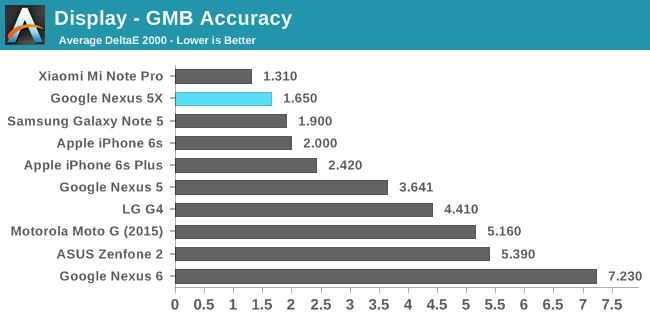
Once again the Nexus 5X provides an incredibly high level of accuracy, with color mixtures being reproduced almost as accurately as primary and secondary colors. It's not the absolute best result on record due to the Mi Note Pro's even higher level of accuracy, but you would only be able to tell that the rendition is wrong if you had the color right beside the reference color with absolutely no motion occurring, and that's well beyond the level of accuracy that is really necessary for a mobile device.
I really don't know what else to say about the Nexus 5X's display, because there's really nothing that can be criticized. I would certainly like if the brightness went up to 600 nits, but I would also prefer that it went to 6000 nits, and obviously that's asking a bit much. As far as LCDs go, the Nexus 5X has one of the best, if not the best that I've seen to date. At this point Google and their OEM partners are going to have to look to gamut as a vector of improvement, but only after proper color management is available at the OS level in order to avoid the problems that have plagued wider gamut displays, which have lacked suitable color management to properly map sRGB content into the wider color space.


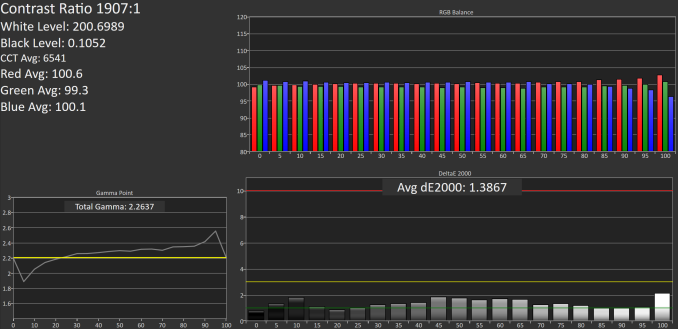
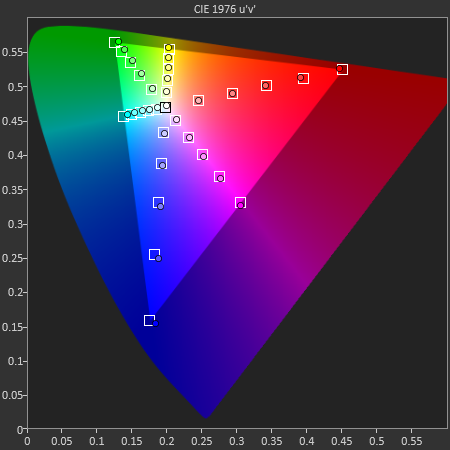









197 Comments
View All Comments
kspirit - Monday, November 9, 2015 - link
Really impatiently waiting for an AT review of Moto X. It's either this or Moto X for me and I will *not* buy until I've got two AT reviews to compare.hans_ober - Monday, November 9, 2015 - link
I'd go with the 5X :)Main 'Nexus' concerns I've always had were camera and battery - which google has sorted out this time with the 5X.
3DoubleD - Monday, November 9, 2015 - link
Thankfully, I did not wait for Anandtech to review the Moto X Play, I just bought it.While I can't offer nearly the review dept of Anandtech, it is plenty fast for everything I've used it for (3D games, multitasking, browsing, ect.). It is a great phone. Similar price the the Nexus (although anecdote-ally, mine was cheaper at $399 - $50 Visa card - value of a 2nd Quick Charge charger - plus I didn't have to pay up front). The battery life is just unparalleled. Display looks great in all conditions. Good hand feel, but I got a case because I'm reckless sometimes. Call quality is excellent. Front speaker is plenty loud. Camera is OK, good in light, passable in low light. Motorola updates Android slightly slower than the Nexus phones, but barely. Android is stock. Has an microSD slot. Wifi reception is great in my experience. Does NOT have a notification LED, but has the low power on screen notification system that works fine (although deep down I slightly miss the LED).
Mainly, compared to the Nexus 5X you are sacrificing the slightest amount of real world SoC performance for more battery life and an SD card slot. The screen on the Moto X Play is also slightly bigger. Either way, you'd probably be happy.
3DoubleD - Monday, November 9, 2015 - link
I should add that you also forgo the fingerprint scanner with the Moto X Play versus the Nexus 5X. The importance of this feature depends whether you think mobile phone payment will catch on where you live. I would be incredibly surprised if it was widely adopted where I live (Canada) over the next 2 years.Bob Todd - Monday, November 9, 2015 - link
The fingerprint scanner becomes a sanity saving mechanism when you have unlocked your gadget for the billionth time and realize you are totally sick of doing so. Why would you think it is only important to payments? Integration with password software is also huge. I logged into this site with my fingerprint...erple2 - Monday, November 9, 2015 - link
This! I think that the fingerprint sensor is going to become a defacto replacement for entering your password in to your phone (for better or worse), but I'm all for it. Entering a 15 digit password with upper/lower case, numbers and special characters is a pain on a smartphone. If that can be circumvented with the (admittedly great) fingerprint sensor (I have a 5X), then I'm all for it.Bob Todd - Monday, November 9, 2015 - link
Most people that think they aren't a big deal usually haven't gotten to use a good one for any extended amount of time. I had one of the first Android devices with a fingerprint sensor (Motorola Atrix). That sensor was garbage compared to what's available today and I wouldn't pay an extra penny to have one like that included on a phone. Sensors like what Apple has been putting out or what's in these Nexus devices? They are absolutely one of the biggest changes to the entire user experience for anyone who is on their phone for whatever reason throughout the day. I'd easily pay over $100 just for a good fingerprint sensor. I contemplated a Moto X Pure but just couldn't do it because of that omission alone. My work phones were iPhones, and when I got my iPhone 6 it made me loathe anything on my personal phone that required a PIN or password. I could never go back to a phone without some kind of streamlined biometric login.twizzlebizzle22 - Monday, November 9, 2015 - link
Not sure on the test but my Nexus 6P NAND seems pretty quick when running androbench. Even for an encrypted device.Glock24 - Monday, November 9, 2015 - link
It does not seem like a good value, especially considering the limited storage options and no SD slot. 2GB RAM seem limited too.Bob Todd - Monday, November 9, 2015 - link
I think the biggest problem with this phone is that it doesn't seem like a good value compared to the 6P. Google made it really hard to choose the 5X.The "small" Nexus is still large at 5.2". They need more than half an inch separating the phones. This one should have been 4.7".
There's only a $70 difference for equivalent capacities. Which is really about $60 when you realize the 5X doesn't come with an A-> C cable but the 6P does.
The 6P has great front facing stereo speakers. The 6P has a more capable camera system (e.g. burst and 240fps slow motion). The 6P has a premium build. The 6P has 3GB of RAM. The 6P has a higher resolution display (I think over 1080p is overkill on a phone, but it impacts the BOM). The 6P has the (theoretically) better SOC. The list goes on.
You are giving up a lot for a small price advantage, at least based on US prices. If the "small" Nexus was actually reasonably compact I think it would fill a more important niche. With both being big ass phones, the decision to go for the 6P was easy to make.